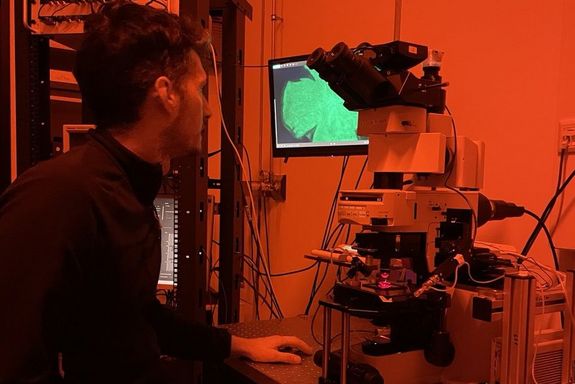In some people, the light receptors on the retina are damaged, but the underlying nerve structure is still intact. In this case, a visual implant could potentially help in the future: Biocompatible, thin photovoltaic films register radiation, convert it into electrical signals, and use these to stimulate living nerve tissue. This has now been achieved for the first time in laboratory tests at TU Wien.
The eye works the wrong way
Our eye is constructed in a way that seems counterintuitive: incoming light passes through several layers of retinal neurons before reaching the photoreceptors, which are the cells that actually detect light. Only then does the signal travel back through a neural network, where the information from the photoreceptors is processed, before it finally reaches the ganglion cells and is transmitted to the brain. It's a bit like placing the cables directly in front of the lens of a camera and taking all the pictures through a tangled mess of cables. But our sense of sight copes with this – we have perfected this strange signal route in the course of evolution.
“In previous attempts to replace damaged photoreceptors with artificial electrodes, the ganglion cells were often stimulated directly,” explains Prof. Günther Zeck from the Institute of Biomedical Electronics at TU Wien. "However, this means that the signal processing that normally takes place in the nerve network behind the retina is not utilized. This results in a distorted, unsatisfactory optical impression.“ It is also possible to stimulate the nerve network – this has already been attempted using silicon-based photodiodes. However, these are hard and inflexible, which makes their use in a living eye highly impractical.”
Utilizing the natural nerve network
At TU Wien, a different approach was taken: biocompatible organic photovoltaic sensors were placed behind the retina and used to stimulate not the ganglion cells directly, but the nerve network that is also used in the natural visual process, which in turn activates the ganglion cells. This produces a signal that much better corresponds to what results from a natural visual process.
However, the photo sensor does not perceive visible light; it reacts to wavelengths in the infrared range. These waves are hardly filtered by the retina, so they pass relatively unhindered through the eye to the sensor.
At TU Wien, retinal tissue from mice that had almost no photoreceptors was examined. However, the ganglion cells and the underlying nerve network layers were intact. The photosensor was placed behind this tissue, and then the entire system was illuminated with infrared light. The signals generated in the ganglion cells were then measured.
“The ganglion cells show a pattern of activity that is very close to the natural behavior in a healthy eye,” says Andrea Corna, first author of the current publication. “This is only possible because we do not stimulate the ganglion cells directly, but rather the natural nerve network, which processes the data in the correct way and then passes it on to the ganglion cells.”
Important step toward a visual prosthesis
With the new, organic D18:Y6 photovoltaic layer, the research team has succeeded for the first time in reliably generating electrical signals in the subretinal area using an ultra-thin, flexible organic material, thereby activating the natural neural network of the retina.
At the same time, it was shown that the material is well tolerated in contact with biological tissue – an important prerequisite for medical applications. “These results open up new perspectives for the development of flexible, biocompatible, and wirelessly operated retinal implants that could enable significantly more natural visual impressions in the future,” hopes Günther Zeck. “The next steps are to further optimize the architecture of the electrodes, control the stimulation even more precisely, and further develop the technology to one day realize high-resolution, miniaturized implants.”
Original publication
A. Corna et al., Near-Infrared Organic Photovoltaic Electrodes for Subretinal Neurostimulation, Advanced Functional Materilas (2025). https://advanced.onlinelibrary.wiley.com/doi/10.1002/adfm.202515327, opens an external URL in a new window
Contact
Prof. Günther Zeck
Institut für Biomedizinische Elektronik
TU Wien
+43 1 58801 363100
guenther.zeck@tuwien.ac.at
Dr. Andrea Corna
Institut für Biomedizinische Elektronik
TU Wien
+43 1 58801 363101
andrea.corna@tuwien.ac.at
